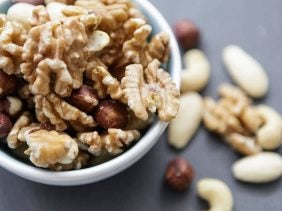6 No-Fail Tips for Muscle Definition
 ©jacoblund
©jacoblund
You’ve probably heard the old saying: abs are made in the kitchen. What that means is that if your aim is muscle definition, it’s not enough to do core work and exercise consistently. It’s also important to prioritize your diet.
Now, it goes without saying that having muscle definition does not need to be your highest priority. In fact, the biggest factor in whether you have a ton of muscle definition, and whether your genetics support that desire. Because genetics control an outsize amount of how you look physically, and how your body functions on the inside—including the speed at which you build muscle, and your propensity to store fat and where. You’ve probably meant people who can decide on a whim to eat cleaner and start weightlifting again, and a few weeks later they look like they’re about to audition for a role in a comic book movie. But if that’s not you, then don’t sweat it. It’s way more important to feel good in your body than it is to look good in your body.
But if you have muscle definition as a top priority, there are things you can try. For instance, there are athletes who have spent months or years building muscle mass, but they don’t have as much muscle definition as they want. If that’s a high priority, the solution might be to increase the amount of cardiovascular work you do and add more endurance exercise.
Want to learn more about building for your body? Take our Body Check here!
- Increase your protein intake
Proteins are essential for cell structure and muscle building. According to the American College of Sports Medicine (ACSM), we should be getting between 10% and 35% of our daily energy intake from protein. So if you take in about 2,000 calories a day, that means you’re looking at 200 to 700 calories of protein a day. To work out the right amount of protein based on your body weight, the Academy of Nutrition and Dietetics has given us a formula. It says we should be eating 0.35 grams of protein per pound of body weight. For a person who’s 165 pounds, that works out to 60 grams of protein a day, for an 180-pound person that’s 63 grams, and 75 grams if you weigh 215.
However, if you’re looking specifically to build muscle mass, your protein intake can bump as well, according to the ACSM. Aim for 0.5 to 0.8 grams per pound of body weight. For a 165 pound person, that’s 83 to 132 grams, for a 180 pound person it’s 90 to 144 grams, and for a 215 pound person it’s 180 to 172 grams.
If you’re not getting sufficient amounts of protein through your diet, the body has ways of finding it, but you’re not going to like them. Usually, it falls back on protein stored in the muscle and synthesizes it instead.
Related: High protein vegan foods
2) Use high-quality protein sources
There are plenty of great animal and non-animal ways of getting protein. Animal sources are obvious—beef, poultry, fish, and dairy products among them. However, the trick is choosing quality. It’s more expensive, but buying farm-raised meat from purveyors who respect animal welfare is preferred. It’s better for you, the animals, and the environment. For instance, factory-farmed meat overuses antibiotics, which is leading to the creation of superbugs. And grass-fed beef may contain a lower fat content, a bigger dose of omega-3 and omega-6 fatty acids, as well a higher antioxidant load.
If you are plant-based, you can also get all the protein you need without eating animal product. You’ve probably heard that there are both complete and incomplete proteins. Complete proteins means that the food contains all nine essential amino acids—meaning the ones we need to get through food in order to build protein. All animal sources of protein are complete proteins, as do protein powders and bars.
But plenty of vegetarian and vegan athletes can put on muscle just fine. A few plant-based foods, including tofu and quinoa, contain complete proteins. Getting a mix of protein-rich foods—seeds, beans, legumes, whole grains, nut butters, and more contain complementary amino acid profiles. Meaning if you eat a smattering of protein-rich vegetarian options, at the end of the day you’ll net enough complete protein. And if you’re concerned about getting a meal with a complete protein quickly enough after a hard workout, you can always try a plant-based protein powder, or a protein-supplemented oatmeal.
One thing to keep in mind is the amount of protein you get in one go. The body can process only so much protein at once—25 to 40 grams—so think about getting doses of protein in meals and snacks over the day.
3) Don’t forget fruits and vegetables
Let’s play a word association game. When we say “muscle-building,” what word comes to mind? Protein. True, but the body needs to be functioning properly in all of its systems if you want to feel powerful and look muscular. That means taking in produce. We’re talking leafy greens (spinach, kale, lettuce, bok choy), cruciferous vegetables (broccoli, Brussels sprouts), colorful peppers, onions and garlic, root vegetables (turnips, carrots), berries, citrus, stone fruit, and more. Really spend some time in the produce department and see what appeals to you. Vary up the fruits and vegetables you eat, all of which have a slightly different nutritional profile of vitamins, minerals, and micronutrients. And calorically speaking, you get a lot of bang for your buck. Produce—and especially vegetables—are bulky but not calorie dense.
4) Pay attention to your overall consumption
We’ve all heard that if you want to build muscle, you have to focus on eating enough. And while that’s true, if your goal is specifically definition, you might not to eat quite so much. Take this as an opportunity to get back in touch with your hunger cues, which you might have started to quiet down in an effort to take in a lot of food and stoke that muscle synthesis. If you’re used to eating a huge bowl of oatmeal, berries, and nuts in the morning, but your hunger for it tapers halfway through the meal, sweet what would happen if you put it away halfway through.
Or if you find yourself craving a meal that isn’t necessarily protein-heavy, that’s ok. Reply to the things your body is asking for, including things like sandwiches or pasta. The body needs all of the macronutrients for supplying the energy you use to function, and keeping all of the bones, tissue, organs, and systems doing cellular turnover.
But you still want to properly fuel your workouts. Have a meal with 50 to 100 grams of carbohydrates and 20 to 30 grams of protein about one hour before a workout. And after you sweat, eat a quick snack of carbs and protein. Post-workout shakes are great if you’re short on time.
5) Find the right combination of weight training and endurance workouts
Pumping iron is great for muscle building, but if you’ve been doing it for ages and you’re feeling strong, but your heard work isn’t as obvious as you want it to be, it might be time to bump your endurance workouts. That means running, rowing, skiing, cardio group classes, jumping rope, and more. And maybe have some fun, too. When’s the last time you hit the basketball court, played flag football, or went for a hike with friends? And since retro is cool, it’s high time you pulled out those rollerblades gathering dust. If you’ve let some of your favorite athletic hobbies fall by the wayside, it’s a great time to find them again. Varying your cross-training is energy-intensive, helps to deflect injury versus doing the same thing over and over, and is just plain fun—which will keep you excited and engaged in your training.
Related: To build strong shoulders, core and endurance, hit the plank
6) Take your time.
Muscles are slow-building, so you’ve gotta give them a chance to do their thing. Since regeneration plays an important role in muscle definition, make sure you’re taking breaks and getting enough sleep. Muscles regenerate best with workout intervals of 24 to 48 hours. Prioritise getting 7 to 8 hours of sleep per night. Shuteye isn’t just rest – it’s a time when the body regenerates.
More healthy living tips from foodspring:
- More performance in the gym through mobility training
- The #1 Reason Your Muscles Aren’t Growing
- 6 Surprising Effects Lifting Weights, According to Science
- Push & Pull – The Only 6 Moves Your Need to Know to Build Strength
Sources for this article
We at foodspring use only high-quality sources, including peer-reviewed studies, to support the facts within our articles. Read our editorial policy to learn more about how we fact-check and keep our content accurate, reliable, and trustworthy.

































